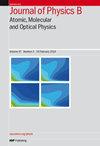Artificial gauge fields and topology with ultracold atoms in optical lattices
IF 1.5
4区 物理与天体物理
Q3 OPTICS
Journal of Physics B: Atomic, Molecular and Optical Physics
Pub Date : 2018-09-12
DOI:10.1088/1361-6455/aac120
引用次数: 9
Abstract
Topological many-body phases of matter exhibit remarkable electronic properties and ultracold atoms in optical lattices constitute promising candidates to study them in a well-controlled environment. In two-dimensional (2D) electron gases topological phases may emerge in the presence of strong magnetic fields. This situation is not directly applicable to cold atoms because they are charge neutral. Therefore, novel experimental techniques have been developed to engineer novel lattice systems, whose Hamiltonian is formally equivalent to the one of charged particles in magnetic fields. In this Tutorial, we introduce a paradigmatic topological lattice model, the Hofstadter model, and explain how it can be implemented with ultracold atoms using laser-assisted tunneling. The technique is based on imprinting phases on the tunneling matrix elements using additional laser beams. These phases are reminiscent of Aharonov–Bohm phases and can be interpreted as a magnetic flux piercing the lattice unit cell. We present experimental results on the cyclotron-like dynamics of neutral atoms in isolated four-site square plaquettes and discuss the first measurement of a 2D topological invariant, the Chern number, in artificially generated Hofstadter bands. The work presented in this Tutorial was one of the four shortlisted finalists of the 2016 DPG SAMOP dissertation prize.光学晶格中具有超冷原子的人工规范场和拓扑
物质的拓扑多体相表现出显著的电子特性,光学晶格中的超冷原子是在良好控制环境下研究它们的有希望的候选者。在二维(2D)电子气体中,在强磁场的存在下可能出现拓扑相。这种情况不能直接适用于冷原子,因为它们是电荷中性的。因此,开发了新的实验技术来设计新的晶格系统,其哈密顿量在形式上相当于磁场中的带电粒子。在本教程中,我们介绍了一个范例拓扑晶格模型,Hofstadter模型,并解释了如何使用激光辅助隧道将其与超冷原子一起实现。该技术基于使用附加激光束在隧穿矩阵元素上刻印相位。这些相让人想起Aharonov-Bohm相,可以解释为穿透晶格单元的磁通量。我们介绍了孤立的四位点方形斑块中中性原子的回旋动力学的实验结果,并讨论了人工产生的霍夫施塔特带中二维拓扑不变量陈恩数的第一次测量。本教程中介绍的作品是2016年DPG SAMOP论文奖的四个入围决赛作品之一。
本文章由计算机程序翻译,如有差异,请以英文原文为准。
求助全文
约1分钟内获得全文
求助全文
来源期刊
CiteScore
3.60
自引率
6.20%
发文量
182
审稿时长
2.8 months
期刊介绍:
Published twice-monthly (24 issues per year), Journal of Physics B: Atomic, Molecular and Optical Physics covers the study of atoms, ions, molecules and clusters, and their structure and interactions with particles, photons or fields. The journal also publishes articles dealing with those aspects of spectroscopy, quantum optics and non-linear optics, laser physics, astrophysics, plasma physics, chemical physics, optical cooling and trapping and other investigations where the objects of study are the elementary atomic, ionic or molecular properties of processes.

 求助内容:
求助内容: 应助结果提醒方式:
应助结果提醒方式:


